Research
Research News
Total 81
-
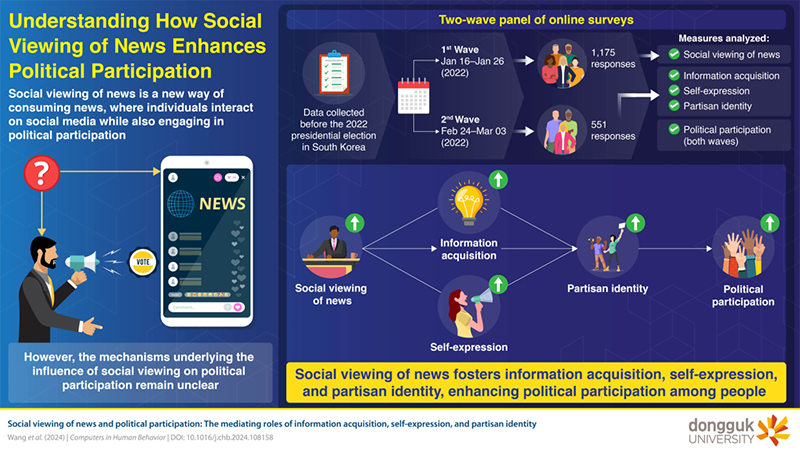
Impact of Social Viewing of News on Political Participation and Identity Formation
Social viewing of news, an emerging trend where news consumption and opinion sharing go hand in hand, significantly increases political participation. However, the underlying mechanisms driving this impact remain unclear. Scientists at Dongguk University have now identified the mediating factors—information acquisition, self-expression, and partisan identity—that drive political participation. These findings offer practical insights for political parties, news organizations, and media policymakers to fuel political participation and foster open discussions within democratic societies.With advancing technology, people can now watch news on live-streaming apps and share their opinions simultaneously. This new trend, known as social viewing of news, increases citizens’ likelihood of participating in politics, such as donating to political parties and engaging in civic group activities. Yet, how social viewing of news influences political participation remains unclear.Now, however, a recent study led by Professor Yonghwan Kim from the Department of Media and Communication at Dongguk University has developed a theoretical model to bridge this gap. Explaining further, Prof. Kim highlights, “Social viewing offers a new way to advance democratic deliberation. Therefore, it's important to explore how social viewing can boost political participation and mobilization.” The study was made available online on 27 January, 2024, and published in Volume 154 of Computers in Human Behavior on May 2024.The research team conducted two online surveys before the 2022 presidential election in South Korea. They found that people who frequently engage social viewing of news, gain diverse knowledge and share their opinions more freely. This makes them feel more attached to a specific political party, which, in turn, makes them more involved in politics.These findings are important for encouraging social viewing of news and citizen engagement in politics. News outlets can share news on social media, and platforms like YouTube can create features for live news viewers to discuss, engaging citizens in politics actively.Nonetheless, concerns linger about potential emotional polarization due to strong partisan identities. Sharing his opinions on this, Prof. Kim suggests, “Exposure to diverse perspectives can reduce polarization. So, social media companies and policymakers should also ensure that comments in online discussions are of high quality. It will help create an open and inclusive space where everyone can participate in discussions for a healthy democracy.”In summary, this study redefines the role of social viewing of news, highlighting its relevance to understanding today's media and political scenario and its impact on political participation and democracy.ReferenceAuthors: Yi Wang1, Yonghwan Kim1, and Han Lin2Title of original paper: Social viewing of news and political participation: The mediating roles of information acquisition, self-expression, and partisan identityJournal: Computers in Human BehaviorDOI: https://doi.org/10.1016/j.chb.2024.108158Affiliations: 1Department of Media and Communication, Dongguk University, Republic of Korea2School of Communication, Soochow University, Suzhou, China*Corresponding author’s email: yhkim17@dongguk.edu (Y. Kim)About Dongguk UniversityDongguk University, founded in 1906, is located in Seoul, South Korea. It comprises 13 colleges that cover a variety of disciplines and has local campuses in Gyeongju, Goyang, and Los Angeles. The university has 1300 professors who conduct independent research and 18000 students undertaking studies in a variety of disciplines. Interaction between disciplines is one of the strengths on which Dongguk prides itself; the university encourages researchers to work across disciplines in Information Technology, Bio Technology, CT, and Buddhism.Website: https://www.dongguk.edu/eng/About the authorsYonghwan Kim (Ph.D., University of Texas at Austin) is a Professor at the Department of Media and Communication at Dongguk University, Seoul, South Korea. His research focuses on emerging information communication technologies such as digital/social media, media convergence, digital journalism, and media effects.Yi Wang (Dongguk University, First author) is a doctoral candidate in the Department of Media and Communication at Dongguk University, Seoul, Republic of Korea. His research interests include media effects, journalism, political communication, and social viewing of news.Han Lin (Ph.D., Dongguk University) is an assistant professor in the Department of Media and Communication at Soochow University, Suzhou, China. His research interests include political communication, journalism, and news fact checking.
2024.04.03. 조회 3305 -
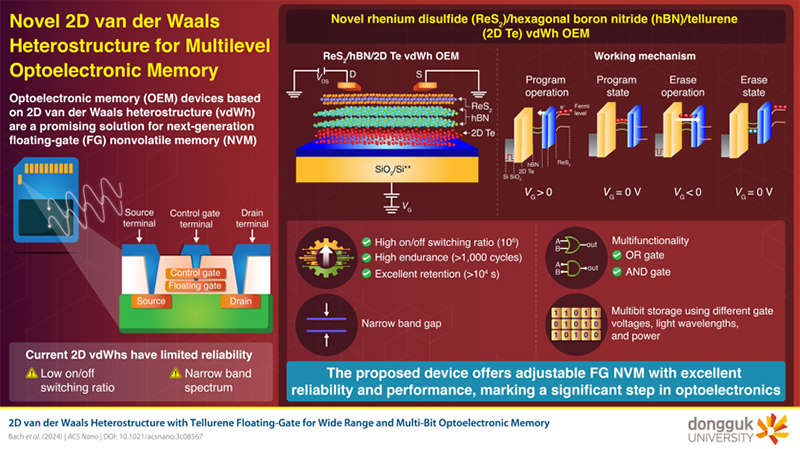
Breakthrough in Memory Technology: Next-Generation Optoelectronic Memory with Tellurene
Researchers developed a novel optoelectronic memory device that addresses the issues of conventional floating-gate nonvolatile memory devices.Despite rapid progress, conventional floating-gate nonvolatile memory devices still face critical challenges. Optoelectronic memory devices (OEMs) based on two-dimensional (2D) van der Waal heterostructures (vdWhs) are a promising solution but suffer from reliability and endurance issues. Addressing these shortcomings, researchers have developed a novel rhenium selenide and 2D tellurene-based vdWh with multilevel storage capabilities, marking a significant step in OEM development.Image title: Operation of the optoelectronic memory device with telluride floating-gateImage caption: The novel optoelectronic memory device exhibits impressive stability and a broad adsorption spectrum, and is capable of multi-bit storage, marking a significant step in floating-gate nonvolatile memory technology.Image credit: Hyunsik Im from Dongguk UniversityLicense type: Original ContentUsage restrictions: Cannot be reused without permissionFloating-gate (FG) nonvolatile memory technology has witnessed rapid development in recent years, offering several advantages in areas like the Internet of Things, multilevel data storage, and next-generation flash memory. Despite this progress, critical challenges such as reducing memory cell size and power consumption are still not solved.A promising solution to these challenges lies in optoelectronic memory (OEM) devices, which can convert light to electricity and vice versa, based on two-dimensional (2D) van der Waal heterostructures (vdWhs). These heterostructures are composed of 2D material layers stacked in a precise order with weak inter-layer bonds, endowing them with unique optoelectrical properties. Previous studies have explored vdWh OEMs using different materials, including graphene, black phosphorous, and perovskite. However, these devices suffer from narrow light absorption spectrums, low on-off switching ratios, and low data retention, limiting their long-term use and reliability.To address these problems, a team of researchers from Dongguk University, Korea, led by Professor Hyunsik Im from the Division of Physics and Semiconductor Science, has developed a novel high-performance OEM based on rhenium disulfide (ReS2)/hexagonal boron nitride (hBN)/tellurene (2D Te) vdWh. Their findings were made available online on January 11, 2024, and published in Volume 18, Issue 05 of the journal ACS Nano on February 06, 2024.The researchers fabricated the OEM device by stacking a few layers of ReS2 on top of a hBN layer followed by a 2D Te FG, all on a silicon dioxide substrate. Tests revealed that the ReS2/hBN/2D Te vdWh device exhibits exceptional long-term stability, a high on/off switching ratio of the order of 106, and impressive data retention, owing to the excellent optoelectrical properties of ReS¬2 and 2D Te. Moreover, it also demonstrated a broad absorption spectrum extending from the visible to near-infrared region at room temperature.Expanding on the results, Prof. Im says, “Our device can achieve multi-bit storage states by varying the gate voltage, input laser wavelength and laser power, enabling complex data patterns and high data capacities.” Furthermore, the device can perform fundamental OR and AND Boolean logic gate operations, crucial for digital circuits, by combining electrical and optical inputs.“Our research marks a significant milestone in multi-bit optoelectronic memory technology, holding great potential in various applications, including artificial intelligence systems, cloud computing, and broadband optical programmability for digital circuits,” concludes Prof. Im.ReferenceTitle of original paper: 2D van der Waals Heterostructure withTellurene Floating-Gate for Wide Range andMulti-Bit Optoelectronic MemoryJournal: ACS NanoDOI: 10.1021/acsnano.3c08567About Dongguk UniversityDongguk University, founded in 1906, is located in Seoul, South Korea. It comprises 13 colleges that cover a variety of disciplines and has local campuses in Gyeongju, Goyang, and Los Angeles. The university has 1300 professors who conduct independent research and 18000 students undertaking studies in a variety of disciplines. Interaction between disciplines is one of the strengths on which Dongguk prides itself; the university encourages researchers to work across disciplines in Information Technology, Bio Technology, CT, and Buddhism.Website: https://www.dongguk.edu/en/About Professor Hyunsik ImHyunsik Im is currently a Professor at the Division of Physics and Semiconductor Science, at Dongguk University, Seoul, Korea. He obtained his D.Phil. degree in Physics at the University of Oxford. His research interests lie in fabrication and electrical transport in nanodevices at low temperatures. His group is also developing approaches for X-ray scintillators and optoelectronic and energy storage devices.About Dr. Duc Anh NguyenDr. Duc Anh Nguyen received the Ph.D. degree at Department of Energy Science, Sungkyunkwan University, Suwon, Korea. He is working as a Research Assistant Professor in the Division of Physics and Semiconductor Science, Dongguk University, Seoul, Korea. His research is currently the synthesis and application of 2D materials for optoelectronic and memory devices.About Thi Phuong Anh BachThi Phuong Anh Bach is currently studying Ph.D. program at the Division of Physics and Semiconductor Science, Dongguk University, Seoul, Korea. Her research focuses on the two-dimensional materials and their heterostructures for optoelectronic devices.
2024.04.02. 조회 3467 -

Professor Kang Jun-won’s Research Team of Dongkuk University Finds New Microplastic Hazards
Published in ‘Water Research,’ the top academic journal in the field of water resources[Jeong-hwan Lee, University News Network] The Dongguk University (President Yoon Jae-woong) Department of Food and Biotechnology Professor Kang Jun-won's research team (master's student Im Ji-hwan (first author), Professor Kang Jun-won (corresponding author)) discovered new hazardous elements that can come from microplastics.Microplastics 5mm or less in diameter are widely distributed around us and enter the human body through various routes. Ingestion through food is considered the main exposure route.▲ Professor Kang Jun-won (Left), Master’s Student Im Ji-hwan (First Author)It is widely known that microplastics that enter the human body can accumulate in tissue and organs and cause direct harm to human health. Meanwhile, it has recently been suggested that microplastics can also serve as a carrier for various contaminants, which means that microplastics can also indirectly adversely affect the body. However, studies have focused only on the direct effects of microplastics, and no study has evaluated these indirect risks.Professor Kang Jun-won's research team evaluated the risk factors that could occur indirectly by attaching food-poisoning bacteria (vibrio parahaemolyticus) to five types of microplastics (LDPE, HDPE, PET, PP, and PS). The team found that food-poisoning bacteria form a biofilm, increasing resistance to food processing conditions and gastric acid after ingestion and increasing the expression of toxic genes that cause food poisoning when attached to microplastics. In addition, the team observed that these risk factors increase even further when microplastics are exposed to environments such as sunlight and age. These findings suggest that the direct risk factors that microplastics in food pose to the human body and the indirect risk factors that can be caused by food poisoning bacteria require a thorough evaluation through further studies.“The research holds significance as it presents new microplastic hazards,” said Professor Kang Jun-won, “We hope that it will contribute to managing microplastics, which threaten food safety and public health, more systematically.”This study was published in〈Water Research〉 (IF=12.8, JCR top 0.5% (No. 1 in the field)), the journal with the highest authority in the water resources field, under the title 'Assessing biofilm formation and resistance of vibrio parahaemolyticus on UV-aged microplastics in aquatic environments.'
2024.03.18. 조회 3840 -
Dongguk University’s Professor Ryu Seung-yoon’s Research Team Publishes a Paper in an Internationally Renowned Academic Journal in the Materials, Physics, and Chemistry Field with Professor Cho Shin-haeng’s Research Team of Chonna
Released a progress report on research utilizing medical equipment (linear particle accelerator) to present an indicator for radiation exposure based on the perovskite solar cellPublished in the 「Journal of Physical Chemistry C」, a renowned international academic journal in the materials, physics, and chemistry field <From left, Professor Ryu Seung-yoon, Professor Cho Shin-haeng, Ph. D. Kim Sang-soo, Ph. D. Candidate Lee Chang-min>○ Professor Ryu Seung-yoon’s team at the Department of Physics and Semiconductor of Dongguk University and Professor Cho Shin-haeng’s team at the Department of Radiation Oncology of the Chonnam National University Hwasun Hospital reported the result of the research on the radiation exposure for the application of the perovskite solar cells. This is basic research on its utilization with a dosimeter, which is used in the hospital, and it suggests, along with optical analysis, that the possibility of deducing the dose as the solar cell does not operate normally after a certain threshold in the research.<Overview of the radiation exposure test using a linear particle accelerator><Journal of Physical Chemistry C 2024, 128, 885−893, Cover Image>○ Although there were attempts to apply the existing Amorphous silicon (a-Si) and copper indium gallium selenide solar cells (CIGS) as chromoradiometer for medical use, the utilization of perovskite solar cells with strong radiation resistance was not examined. Under the circumstances, a radiation exposure test using a linear particle accelerator was performed to verify whether they could be utilized in extreme environments like space.○ This research irradiated perovskite solar cells with a 6 MeV electron beam for the first time to imitate an extreme environment. The dosage of radiation used for treatment at hospitals is approximately 1 fx / 50 Gy, but this research increased the level to an extreme dose (3 kGy – 21 kGy) for verification. It suggested that a flaw (vacancy, antisite, or distortion) occurs inside the perovskite crystal, and the performance of the solar cell declines at a certain level (15 kGy).○ In addition, the research team cross-validated the flaw inside the perovskite crystal through optical analysis and simulation and suggested using perovskite solar cells under extreme environments. However, it indicated that additional research is necessary to maintain the stability of the perovskite solar cells to utilize them under extreme environments, such as in space.○ Professor Ryu Seung-yoon said with expectations, “Recently, the need for converged and joint research is emerging in various areas. Experts from various fields can work together to make technology more cutting-edge. With Professor Cho Shin-haeng’s team, we were able to study medical dosimeters and technologies to apply under extreme environments, such as in space, by sharing knowledge.”○ Ph. D. Kim Sang-soo and Ph. D. Candidate Lee Chang-min said, “The stability of the perovskite solar cells is still not very high, and it is difficult to prepare and analyze the element, but we engaged in the research to lay the foundation for researching the use of solar cells under extreme environments considering the strong radiation resistance of the perovskite compared to existing solar cells,” giving their impression.○ This research was funded by the National Research Foundation of Korea and Dongguk University and published online and featured on the cover of the January 2024 edition of the distinguished international academic journal in the materials, physics, and chemistry fields 「Journal of Physical Chemistry C (IF=4.17)」 under the title <Radiation Tolerance of Organohalide-Based Perovskite Solar Cells under 6 MeV Electron Beam Irradiation>.
2024.01.29. 조회 5181 -

Professor Choi Min-jae’s Team at Dongguk University Develops Near-Infrared Photothermal Anticancer Therapy Using Quantum Dots
<From left, Master Yoo Do-heon, Master Jeong Se-hwan, Professor Kim Gyo-beom, and Professor Choi Min-jae>Dongguk University (President Yun Jae-woong) announced on January 22 that the research team of the Department of Chemical Engineering and Biotechnology, comprising Master Yoo Do-heon (First Co-author), Master Jeong Se-hwan (First Co-author), Professor Kim Gyo-beom (Co-corresponding Author), and Professor Choi Min-jae (Co-corresponding Author), succeeded in near-infrared photothermal anticancer therapy.Photothermal anticancer therapy is a noninvasive therapy that applies light to a local area to induce heat generation to eradicate cancer cells selectively. The research team developed eco-friendly quantum dots without in vivo toxicity, used them in their research, and confirmed that they generate heat when irradiated with infrared rays and eradicate cancer cells. While most existing photothermal anticancer therapy uses gold nanoparticles, this research is characterized by using quantum dots.Professor Choi Min-jae’s team said, “Quantum dots are easy to control in the infrared area and have strong potential as the material for infrared photothermal therapy in the future, and we plan to develop photothermal therapies targeting various tumors through follow-up studies.”The research was funded by the National Research Foundation of Korea through the Basic Research Lab Support Project and Excellent New Research Project, and was published in the January 2024 edition of the renowned international academic journal ACS Materials Letters (IF=11.4) under the title “Dual-Ligand Surface Passivation Enables Monodisperse Ag2S Colloidal Quantum Dots for Efficient Near-Infrared Photothermal Therapy.”
2024.01.29. 조회 3297 -
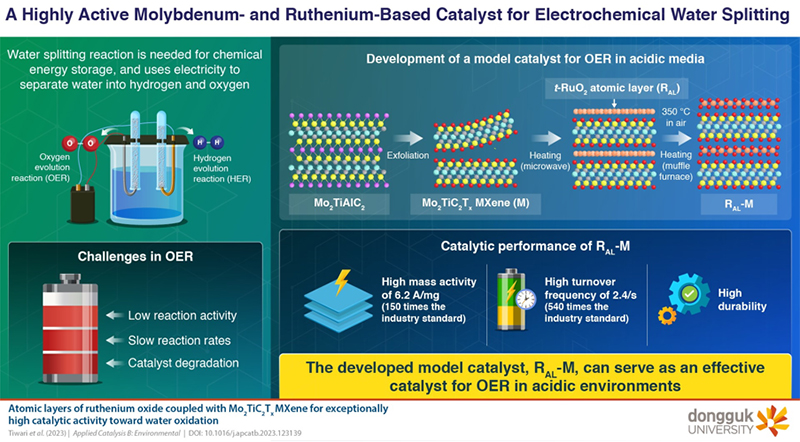
Beyond Carbon: Scientists Design A New Catalyst to Generate Green Fuel from Water
Globally, the transition to greener sources of energy requires the use of efficient catalysts for fuel generation reactions. Now, scientists at Dongguk University have synthesized an efficient catalyst for the oxygen evolution reaction — a component of water-splitting process that produces hydrogen and oxygen. The catalyst, synthesized using molybdenum and ruthenium, exhibits high activity, reaction rates, and durability, opening doors to the cost-effective and large-scale production of next-generation catalysts using diverse materials.Chemical energy storage is a promising solution for circumventing the global energy challenges. Reduction of water to molecular hydrogen via the splitting water reaction is a key method. However, issues like low catalyst activity, slow reaction speed, and catalyst degradation pose challenges.Now, in a recent study led by Professor Young-Kyu Han and Assistant Professor Jitendra N. Tiwari from the Department of Energy and Materials Engineering at Dongguk University, scientists have developed an effective oxygen evolution reaction catalyst with molybdenum and ruthenium. Their study was made available online on July 29, 2023, and published in Volume 339 of Applied Catalysis B: Environmental on December 15, 2023. According to Prof. Han, “Carbon materials are crucial for commercial acidic polymer electrolyte membrane water electrolyzers. At high voltages, however, carbon atoms degrade in strongly acidic media, necessitating the need for new catalyst materials beyond carbon materials.”The study involved implanting ruthenium oxide into a two-dimensional molybdenum carbide to create a catalyst (Mo2TiC2Tx MXene) with high mass activity, turnover frequency, and durability. Calculations also indicated that the ruthenium sites had a strong affinity towards oxygen species, which enhanced the reaction.These findings are significant, as the global aim is to achieve 80% renewable electricity by 2050. Hydrogen and oxygen have diverse industrial applications, spanning clean fuel, power generation, chemical production, and life-support systems. Notably, more than 90% of hydrogen is in petroleum recovery and refining (47%) and ammonia production (45%) alone.The transportation sector will also benefit. Elaborating on this, Dr. Tiwari says, “The need for decarbonizing the transportation sector makes hydrogen a promising alternative. Going ahead, fuel cell vehicles are expected to efficiently convert hydrogen into electrical energy, emitting only water, with longer driving ranges than battery electric vehicles. Additionally, hydrogen fuel cells do not need recharging and don’t degrade if hydrogen fuel is present, unlike in batteries,” observes Dr. Tiwari.This study thus serves as a guide for researchers to create new catalysts for acidic water oxidation. It also sheds light on achieving cost-effective, large-scale catalyst production using diverse materials, such as dual-transition metal catalysts.ReferenceTitle of original paper: Atomic layers of ruthenium oxide coupled with Mo2TiC2Tx MXene for exceptionally high catalytic activity toward water oxidationJournal: Applied Catalysis B: EnvironmentalDOI: 10.1016/j.apcatb.2023.123139*Corresponding authors’ emails:ykenergy@dongguk.edu (Y.-K. Han), jnt_tiw123@yahoo.co.in (J.N. Tiwari), and yunsuk.huh@inha.ac.kr (Y.S. Huh)About Dongguk UniversityDongguk University, founded in 1906, is located in Seoul, South Korea. It comprises 13 colleges that cover a variety of disciplines and has local campuses in Gyeongju, Goyang, and Los Angeles. The university has 1300 professors who conduct independent research and 18000 students undertaking studies in a variety of disciplines. Interaction between disciplines is one of the strengths on which Dongguk prides itself; the university encourages researchers to work across disciplines in Information Technology, Bio Technology, CT, and Buddhism.Website: https://www.dongguk.edu/eng/About the authorsProf. Jitendra N. Tiwari is an Assistant Professor at the Department of Energy and Materials Engineering, Dongguk University, Seoul. His research focuses on the development of carbon and MXene-based catalysts and their applications in energy. He has worked as a postdoctoral, senior scientist, and research-assistant professor at NCTU (Taiwan), POSTECH (Pohang) and UNIST (Ulsan).Prof. Young-Kyu Han is a Full Professor at the Department of Energy and Materials Engineering at Dongguk University, Seoul, Republic of Korea. His current research interests are the quantum simulations of battery and catalyst materials. He is also working on the design of new promising materials based on atomic-level simulation.
2024.01.24. 조회 3600 -
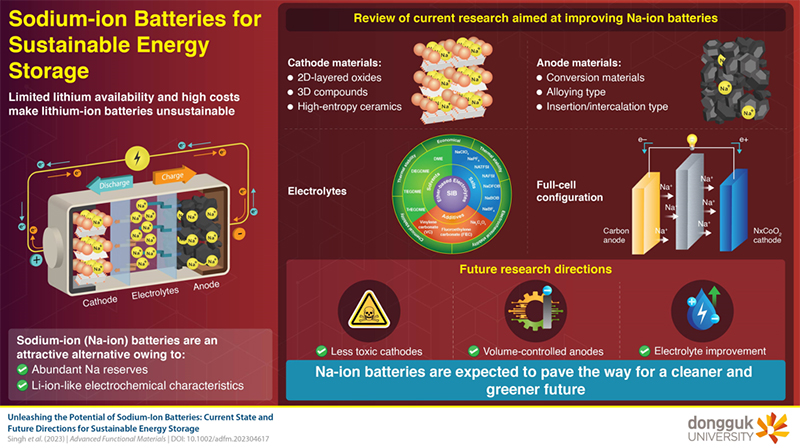
Sodium-Ion Batteries: The Future of Sustainable Energy Storage
Lithium-ion batteries (LIBs) have become essential for energy storage systems. However, limited availability of lithium has raised concerns about the sustainability of LIBs. In a new study, scientists from Dongguk University reviewed the recent advances in sodium-ion battery technology, a potential alternative to LIBs. Their findings can inspire young researchers to combat the current challenges of SIBs for their rapid commercialization.With the rapid increase in global energy demand and a growing shift toward renewable energy sources, lithium-ion batteries (LIBs) have become an indispensable part of our daily lives. However, the limited availability of lithium and the consequent increase in its costs have raised concerns about the sustainability of LIBs. As an alternative, sodium-ion batteries (SIBs) have gained considerable attention. SIBs offer many advantages, because their raw materials are naturally abundant, safe, and share a similar chemistry to the already mature LIB technology. However, despite these benefits, there are many challenges that impede the commercialization of SIBs.To highlight these challenges and their potential solutions, a multinational team of researchers led by Professor Kyung-Wan Nam from the Department of Energy and Materials Engineering at Dongguk University, Korea, recently reviewed the recent advances in SIB technology. “We believe that highlighting the advances and challenges of current SIB technology not only inspires young researchers but also provides valuable insights for enhancing the performance and commercialization of SIBs.” says Prof. Nam, while talking about the study. The study was made available online on July 4, 2023, and published in Volume 33, Issue 46 of the journal Advanced Functional Materials on November 9, 2023.The team identified the main research areas in SIB technology, emphasizing the development of cathode and anode materials, electrolytes, and full-cell configurations. While most studies till now have only focused on half-cell configurations, full-cell configurations for SIBs can serve as a long-term alternative to LIBs. Fortunately, emerging energy companies and many researchers are working toward realizing practical full-cell SIBs.The team also highlighted future research directions, urging to eliminate the use of toxic substances in cathodes and design of volume-controlled anodes. Furthermore, they also suggested that electrolytes will make significant improvements in both the cycle life and performance of SIBs.“While the cost of SIBs might be slightly lower and comparable to LIBs, the availability of sodium and the use of less toxic materials makes them a great alternative. In the long term, SIB can complement LIB technology, rather than being a competitor,” says Prof. Nam.The team expresses confidence that most of the current challenges will be addressed in the coming years, paving the way for a cleaner and greener tomorrow!ReferenceTitle of original paper: Unleashing the Potential of Sodium-Ion Batteries: Current State and Future Directions for Sustainable Energy StorageJournal: Advanced Functional MaterialsDOI: 10.1002/adfm.202304617*Corresponding authors’ emails: aditya@dongguk.edu (A.N.S.); knam@dongguk.edu (K.W.N.)About Dongguk UniversityWebsite: https://www.dongguk.edu/eng/
2023.12.21. 조회 3216 -

Manganese Complex Leads the Way to Affordable and Sustainable Bright White OLEDs
Scientists at Dongguk University have developed a new environmentally friendly and cost-effective bright green light-emitting manganese complex called MnBz for organic light-emitting diodes (OLEDs). The material was used to fabricate a first-of-its-kind Mn-based white OLED device and a green OLED device with record high efficiency.Organic light-emitting diodes (OLEDs) are considered new and promising light sources for illuminating digital displays and indoor/outdoor spaces. One of the most popular commercial methods for fabricating OLEDs is the solution processing approach. However, while the fabrication process of such LEDs itself is low-cost and simple, the raw materials used during solution process often include precious and expensive metals such as rare earth metals, driving up the fabrication costs.Studies have shown that low-dimensional complexes of earth-abundant transition metals could be the key to solving this problem. To develop a promising solution using this approach, a team of researchers led by Assistant Professor Vijaya Gopalan Sree from Dongguk University recently attempted to synthesize zero-dimensional manganese (Mn)-based complexes for OLEDs via solution processing. In their recent breakthrough made available online on 7 September 2023 and published in Volume 474 of the Chemical Engineering Journal on 15 October 2023, the team has laid out the strategy for fabricating a bright green-light-emitting Mn (II) complex MnBz, which was further utilized to design a first-of-its-kind warm-white OLED device."Replacing expensive rare earth metals like gold and platinum with crystalline earth-abundant transition metal complexes can help achieve lightning solutions or displays that are cheaper yet bright and vibrant,” says Dr. Sree, talking about their motivation to explore new materials for OLEDs.In this study, the researchers synthesized MnBz by subjecting manganese bromide (MnBr2) and benzyltriphenylphosphonium bromide (Ph3BzPBr) to solvent-free grinding, followed by dissolution in acetonitrile solvent. The resulting solution was slowly evaporated over days to obtain single crystals of MnBz. The thus obtained MnBz exhibited bright green-light emissions with a narrow emission spectrum and high quantum yield.The team then used the single crystals of MnBz to design a novel Mn(II) complex-based warm-white light-emitting device, which exhibited an excellent color rendering index (CRI) of 78. MnBz was also used to design a green phosphorescent OLED device, which exhibited excellent performance. These light emitters displayed a record-breaking quantum efficiency of 11.42% and current efficiency of 56.84 cd A-1.The exceptional brightness of these MnBz-based devices in response to low turn-on voltages can pave the way for energy-efficient OLED-based consumer electronics and lighting systems. Explaining further, Dr. Sree adds, “Our new eco-friendly and cost-effective light emitter can facilitate developments towards a wider adoption of OLEDs and ultimately impact people's lives by transforming the way we interact with and illuminate our world.”ReferenceTitle of original paper: Green and warm-white light-emitting diodes enabled by zero-dimensional green-emitting Mn(II) bromide complex with record high efficiencyJournal: Chemical Engineering JournalDOI: 10.1016/j.cej.2023.145936*Corresponding author’s email: hyunsik7@dongguk.eduAbout Dongguk UniversityDongguk University, founded in 1906, is located in Seoul, South Korea. It comprises 13 colleges that cover a variety of disciplines and has local campuses in Gyeongju, Goyang, and Los Angeles. The university has 1300 professors who conduct independent research and 18000 students undertaking studies in a variety of disciplines. Interaction between disciplines is one of the strengths on which Dongguk prides itself; the university encourages researchers to work across disciplines in Information Technology, Bio-Technology, CT, and Buddhism.Website: http://www.dongguk.edu/mbs/en/index.jspAbout the authorDr. Vijaya Gopalan Sree (first author) is currently an Assistant Professor in the Division of Physics and Semiconductor Science at Dongguk University, Seoul, South Korea. He received his D. Phil. degree from Pusan National University, Busan, South Korea (2015–2019) and formerly worked as a postdoctoral research associate at the Center for Superfunctional Materials, UNIST, Ulsan, South Korea (2019–2020). His research involves the design, engineering, and development of novel materials (organic and organometallic) that are cheaper and more efficient alternatives for applications in energy storage and optoelectronics.Prof. Hyunsik Im (corresponding author) received his D.Phil. degree in physics from the University of Oxford. After postdoctoral research in the Clarendon Laboratory at Oxford and Institute of Industrial Science at the University of Tokyo, he was appointed assistant professor in the Department of Physics and Semiconductor Science at Dongguk University in 2001, was promoted to full professor in 2011. His research areas include optoelectronic and mesoscopic physics in solid-state materials.(Webpage: https://sites.google.com/view/edlabdgu)
2023.11.27. 조회 3911 -
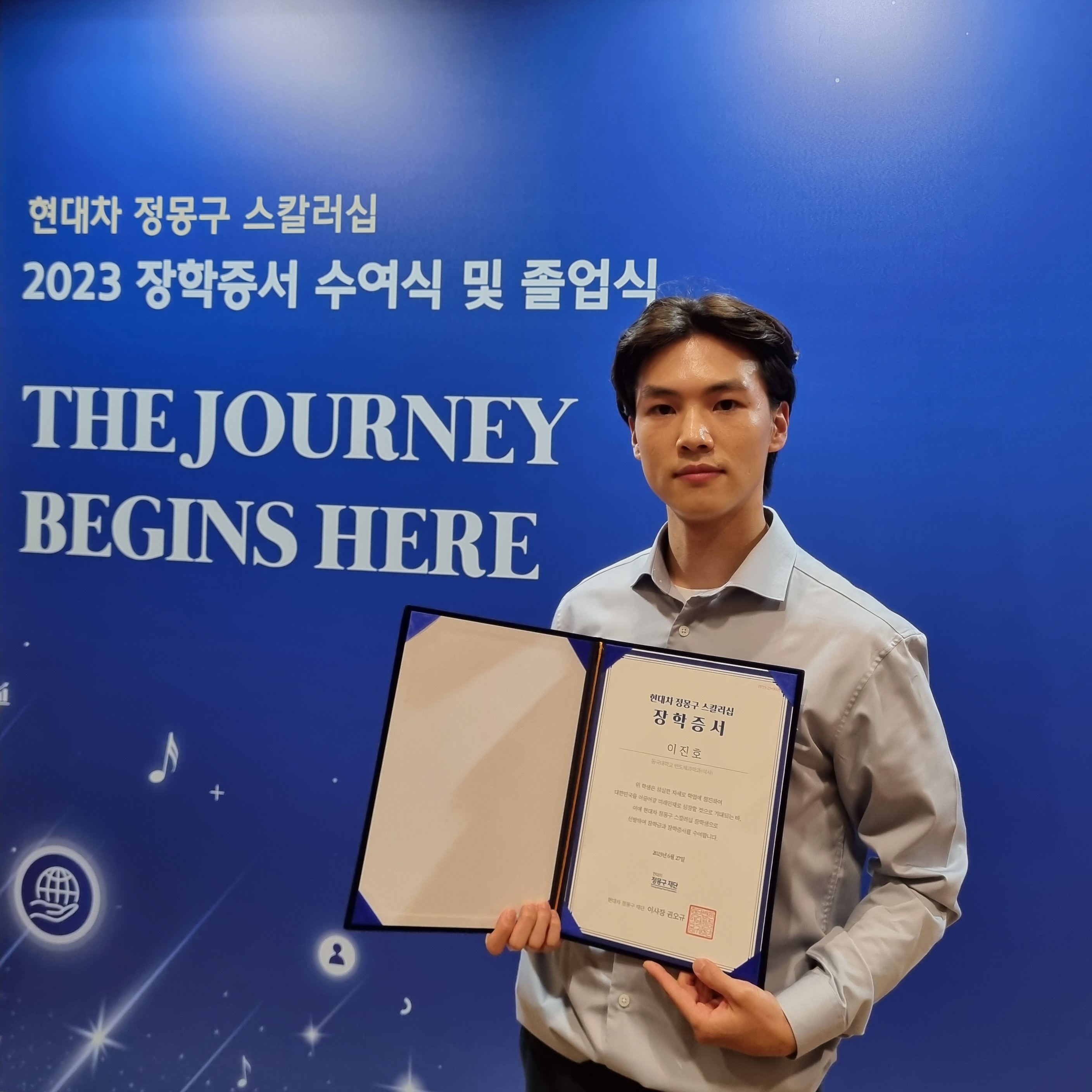
Graduate student Lee Jin-ho of the Department of Semiconductor Science Wins Hyundai Motor Chung Mong-Koo Scholarship
Lee Jin-ho of the Department of Semiconductor Science (Master's course) was selected as a Hyundai Motor Company Chung Mong-Koo Scholarship recipient.The Hyundai Motor Chung Mong-Koo Foundation held the '2023 Scholarship Ceremony and Graduation Ceremony' at the Ramada Seoul Sindorim Hotel on June 27.Lee Jin-ho received the scholarship for 'Intelligent Information Technology' in the field of future industry at the scholarship award ceremony.The student will receive various benefits once selected as a Hyundai Motor Chung Mong-Koo Scholarship student. Full tuition and living expenses are provided alongside growth support packages and networking programs. Additional scholarships are provided to students who publish papers in internationally renowned academic journals and win prizes in international competitions. Other scholarships are also offered for up to five years to a student who expands their activities overseas, such as entering an excellent university (graduate school) within the world’s top 100 universities to foster the scholarship student's growth continuously. Various networking programs, such as summer camp, performance viewing, and a homecoming day, are operated exclusively for the Hyundai Motor Chung Mong-Koo Scholarship students.The Hyundai Motor Chung Mong-Koo Foundation has operated the scholarship program since 2011 and renewed the 'Hyundai Motor Chung Mong-Koo Scholar' under the title 'Hyundai Motor Chung Mong-Koo Scholar' in 2021, reflecting its founder's will to foster talented people: 'Discovering talent builds national competitiveness.' Chung Mong-Koo is the honorary chairman of Hyundai Motor Group. The foundation has promoted the cultivation of 1,100 future talents over five years across six fields, including global future industry, international cooperation, social innovation, culture and arts, and social integration, and actively supported global activities.
2023.08.23. 조회 3455 -

Dongguk University Professor Choi Chang-soon’s Research Team Develops a Clothing-type Energy Harvester
Utilizing Commercialized Fibers, Harvesting External Mechanical Energy into Electrical EnergyDemonstrates the Possibility of Commercializing Wearable Devices with Self-driven Sensors that Detect Human Body MovementOnline Publication of the Latest Edition of ‘Nano Letters,’ a Renowned International Journal in the Nano Field (From left) Dongguk University Department of Energy and Materials Engineering Master Kim Joo-wan, Master Roh Joon-ho, Professor Shim Hyun-joon, and Professor Choi Chang-soon○ Dongguk University Department of Energy and Materials Engineering Master Kim Joo-wan (lead author), Master Roh Joon-ho (co-lead author), Professor Shim Hyun-joon (co-corresponding author), and Professor Choi Chang-soon (corresponding author) announced that they had developed an energy harvester in the form of clothing by coating commercial yarn with graphene.○ They announced that they overcame the limitations of existing research by developing a technology to develop an energy harvester that can function as clothing by mass-producing functional yarn through a simple and continuous process and weaving them.○ Existing mechano-electrochemical-based energy harvesters had many commercialization difficulties, such as expensive materials, complex processes, and mechanical properties unsuitable for direct clothing application. To solve this problem, Professor Choi Chang-soon's research team maintained clothing functionality by simply coating commercial yarn with graphene. In addition, the team reported a wearable energy harvester capable of reproducing mechanical energy repeatedly generated through the wearer's movements into valuable electrical energy through imparting electrical conductivity.○ For proper mechanical properties, fine fibers are twisted and entangled in commercial yarn. The research team led by Professor Choi Chang-soon used this special fiber structure to understand how mechanical energy from the outside may affect the surface area of an energy harvester, which then converts that mechanical energy into electrical energy using electrochemical principles. When woven into the clothing fabric, the produced harvester can be used as a sensor to track human movement. It can detect motion, particularly in direction and intensity, and it has demonstrated promise as a self-driven sensor that runs without external power.○ Professor Choi Chang-soon said, "It is significant that we developed an energy harvester that harvests mechanical energy continuously generated by human body movement into electrical energy, while maintaining the essence of a wearable device." He also expressed his hope that, through mass production, a low-cost process, and the potential for weaving, "it can be used in various fields as self-driven sensors that do not require an external energy device."○ The research results were published online in August 2023 in 「Nano Letters (IF=12.262)」, a renowned international journal in the field of materials, under the title <Hierarchically Plied Mechano-Electrochemical Energy Harvesting Using a Scalable Kinematic Sensing Textile Woven from a Graphene-Coated Commercial Cotton Yarn>.
2023.08.23. 조회 2706




